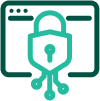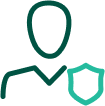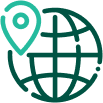
Guaranteed Malware Removal
Protection Against Furture Hacks

24/7 Security Team

30-Day Guarantee

A website intrusion detection system (IDS) monitors and inspects incoming requests to identify indicators of attack, like exploit payloads, credential‑stuffing attempts, or anomalous behavior; so you can stop threats before they reach your application. Paired with a web application firewall (WAF) and prevention rules, IDS becomes a proactive shield against hacks.
At Sucuri, IDS is built into our Web Application Firewall and included in all Complete Website Security Platform plans, so you get layered protection without extra complexity or hidden costs.
Sucuri combines an Intrusion Detection System (IDS) with a Web Application Firewall (WAF) to deliver proactive, layered security. This integration stops attacks before they reach your site by detecting anomalies, blocking malicious traffic, and applying virtual patches in real time. Here are four core protections that make this possible:

We protect your website against malicious code and prevent website hacking with our Web Application Firewall (WAF).

Hackers discover new vulnerabilities every day. We protect sites and stop suspicious behavior. Mitigating new threats rarely requires a patch.
Distributed Denial of Service (DDoS) attacks can cause downtime. We block layer 3, 4, and 7 DDoS attacks.

Automated hacker tools target all sites. We stop brute force attacks and password cracking to prevent site abuse.
Sucuri’s Intrusion Detection System is more than just monitoring—it’s a proactive defense layer built into our Web Application Firewall and included in all Complete Website Security Platform plans. These features work together to detect, block, and mitigate threats in real time, keeping your site secure and fast.

If a security patch is released, but you can’t update your site, it becomes an easy target for hackers. We constantly update patches and server rules to protect your site.

Protect your website from emerging security threats. We correlate attack data across our network to better understand malicious behavior and keep your site secure.

Add another layer of protection to sensitive pages by enabling the Protected Page feature. Add passwords, CAPTCHA, 2FA (via Google Authenticator), or IP allowlisting.

Allowlisted IP addresses ensure that only your team can access website administrative areas. Restrict your admin panels so malicious users don’t gain access.

Each site has its CMS, server software, and other technologies in the stack. We analyze all the traffic to block requests that don’t fit your web application’s profile.

All HTTP/HTTPS web traffic is inspected before reaching your server. With heuristic and signature-based techniques, we block malicious requests and attack patterns.

When our systems detect a malicious bot or hacker tool trying to attack your site, it is blocked automatically. We protect your site from vulnerability exploitation attempts.

Most website attacks come from only a handful of countries. Block all visitors from the top three attack countries with one click or choose which countries to block.
Web traffic is
malicious
Websites are
hacked daily
DDoS attack
increase yearly
Money back
guarantee
Add Your Site to the Sucuri Firewall
Activate Website Protection in Seconds
Add SSL & Protect Data in Transit
Choose from Caching Options
Our global CDN and smart caching improve site speed by up to 60%—while our WAF filters threats in real time.

Layered defense against Layer 3, 4, and 7 attacks, credential stuffing, and brute force attempts powered by machine learning.

Protect outdated plugins and CMS versions without touching your code. Our WAF blocks known exploits instantly.
Activate protection via DNS or dashboard—no installation required. Sucuri scales with your needs, from SMBs to enterprise.

Partners
Deliver proactive protection to your clients. Offer real-time monitoring and threat detection as part of your managed services. Sucuri’s IDS helps you identify issues before they escalate, adding value to your security offerings.

Agencies
Monitor multiple client sites from one dashboard. Stay ahead of threats with centralized alerts and activity logs. Sucuri’s IDS helps agencies maintain uptime and reputation across all hosted websites.

SMBs
Get enterprise-grade visibility without complexity. Sucuri’s IDS monitors file changes, login attempts, and suspicious behavior—so you can focus on running your business while staying protected.

Ecommerce
Protect customer data and transaction integrity. Monitor for unauthorized access, malware injections, and suspicious admin activity. IDS helps ecommerce sites maintain trust and compliance.

Enterprises
Scale monitoring across complex environments. Sucuri’s IDS integrates with your existing infrastructure to provide deep visibility into website activity, helping security teams respond quickly to threats.
Is Sucuri an IDS, IPS, or WAF?
Sucuri combines the strengths of an Intrusion Detection System (IDS) and a Web Application Firewall (WAF) into one solution. Our firewall inspects all HTTP/HTTPS traffic, detects malicious patterns, and actively blocks attacks in real time. This means you get both detection and prevention, plus performance benefits from our global CDN—all in a single platform.
How does virtual patching help with zero‑day and known CVEs?
Virtual patching applies security rules at the edge of your network, blocking exploit attempts before they reach your site. This is critical for zero‑day vulnerabilities and known CVEs because it buys you time to safely update your CMS, plugins, or themes without leaving your site exposed. No code changes are required on your end.
How does Sucuri mitigate DDoS attacks?
Guarantee your website availability and performance against the largest attacks. Our globally distributed Anycast Network and secure content delivery keep your site online during large traffic spikes and massive DDoS attacks.
Will geo‑blocking hurt SEO?
Not if configured correctly. Sucuri’s Geo‑Blocking lets you block POST requests (like logins or form submissions) from high‑risk regions while keeping view access open for search engines and legitimate visitors. This approach minimizes SEO impact while reducing attack surface.
Do I get 24/7 support and a guarantee?
Yes. Our security team is available 24/7/365 via chat and ticket for any issues or questions. All plans include a 30‑day money‑back guarantee, so you can try Sucuri risk‑free.
How do I get started?
Sucuri offers both remote website and server side monitoring. Once these are properly set up, we will scan your website externally and internally for indicators of compromise. You’ll also receive weekly and monthly reports and have access to audit logs.
Our malware monitoring identifies the following:
Take our free email course to learn about educational website security topics from your inbox.

Browse through our meticulously curated selection of advanced security content.